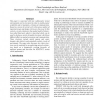Free Online Productivity Tools
i2Speak
i2Symbol
i2OCR
iTex2Img
iWeb2Print
iWeb2Shot
i2Type
iPdf2Split
iPdf2Merge
i2Bopomofo
i2Arabic
i2Style
i2Image
i2PDF
iLatex2Rtf
Sci2ools
WETICE
1997
IEEE
1997
IEEE
Boundaries, Awareness and Interaction in Collaborative Virtual Environments
This paper is concerned with how collaborative virtual environments can be structured in order to enable greater scalability and yet maintain a richness of communication. Based on a survey of current work in this area a number of important issues and design criteria are drawn out. In this context a recent extension to the spatial model of interaction called third party objects is described which can be used to develop a variety of spatial structures which have different effects on mutual awareness and communication. These structures include nested regions and zones, dynamic data districts and potentially mobile crowds of participants. The paper also discusses how these structures can be exploited by an underlying network architecture based on a dynamically evolving hierarchy of multicast groups and describes the MASSIVE-2 system which implements it.
Collaborative Virtual Environments | Dynamic Data Districts | Emerging Technology | Spatial Structures | WETICE 1997 |
Related Content
| Added | 06 Aug 2010 |
| Updated | 06 Aug 2010 |
| Type | Conference |
| Year | 1997 |
| Where | WETICE |
| Authors | Chris Greenhalgh, Steve Benford |
Comments (0)

